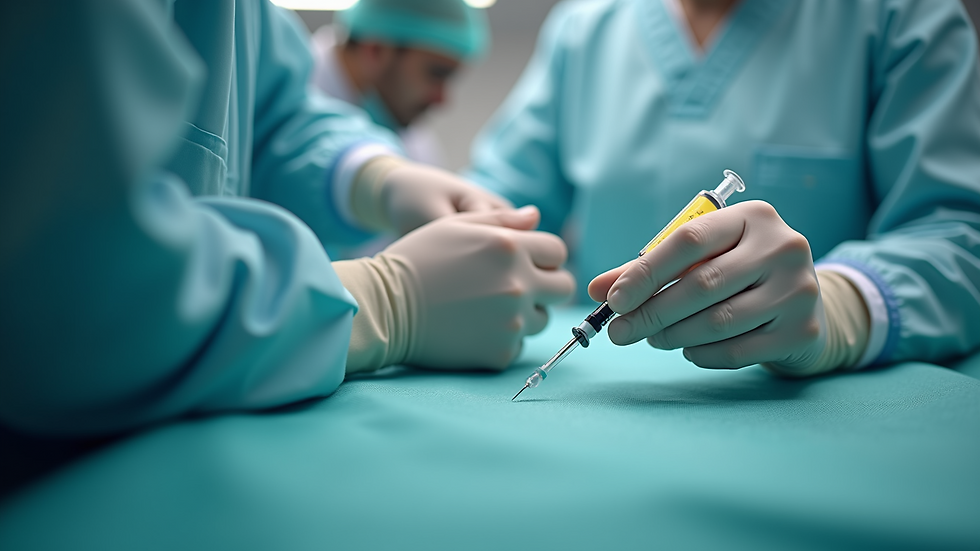Healing with Platelet-Rich Plasma Therapy
- ArchPoint Info

- 4d
- 3 min read
When pain disrupts daily life, finding effective treatment options becomes a priority. One promising approach gaining attention is platelet-rich plasma therapy. This treatment uses the body's own healing components to support recovery and reduce pain. In this article, I will share clear information about how this therapy works, its benefits, and what to expect during the process. My goal is to provide practical insights that can help you make informed decisions about managing pain.
Understanding Platelet-Rich Plasma Therapy
Platelet-rich plasma therapy involves drawing a small amount of blood from the patient and processing it to concentrate the platelets. Platelets are cells that play a key role in healing by releasing growth factors. These growth factors stimulate tissue repair and regeneration. Once the plasma is prepared, it is injected into the injured or painful area to promote healing.
This therapy is used for various conditions, including joint pain, tendon injuries, and arthritis. Because it uses your own blood, the risk of allergic reactions or complications is low. The procedure is minimally invasive and can often be done in an outpatient setting.

Plasma Therapy Benefits for Pain Relief and Healing
The benefits of plasma therapy extend beyond simple pain relief. Here are some key advantages:
Accelerated Healing: The concentrated growth factors in the plasma encourage faster tissue repair. This can shorten recovery times for injuries.
Reduced Inflammation: Plasma therapy helps decrease inflammation in affected areas, which often contributes to pain.
Minimally Invasive: Unlike surgery, this treatment involves only injections, reducing risks and downtime.
Versatility: It can be applied to various musculoskeletal conditions, including tendonitis, ligament injuries, and osteoarthritis.
Natural Approach: Since it uses your own blood components, it avoids synthetic drugs or chemicals.
For example, patients with chronic knee pain from osteoarthritis have reported significant improvement after a series of plasma therapy injections. Similarly, athletes recovering from tendon injuries often experience quicker returns to activity.
What to Expect During the Treatment Process
The treatment process typically begins with a consultation to assess your condition and determine if plasma therapy is appropriate. If so, the procedure usually follows these steps:
Blood Draw: A small amount of blood is taken from your arm.
Processing: The blood is spun in a centrifuge to separate the platelet-rich plasma.
Injection: The concentrated plasma is injected into the targeted area using ultrasound guidance for accuracy.
Recovery: You may experience mild soreness or swelling, but most people resume normal activities quickly.
The number of sessions varies depending on the condition and severity. Some patients see improvement after one treatment, while others may need multiple sessions spaced weeks apart.

Who Can Benefit from This Therapy?
Plasma therapy is suitable for many individuals experiencing pain from musculoskeletal issues. It is especially helpful for those who:
Have chronic joint pain not fully relieved by medication or physical therapy.
Are seeking alternatives to surgery.
Want to avoid long-term use of pain medications.
Are recovering from sports injuries or overuse conditions.
Have conditions like tendonitis, bursitis, or mild to moderate arthritis.
However, it may not be recommended for people with certain blood disorders, infections, or severe joint damage. A thorough evaluation by a pain specialist can help determine if this treatment is right for you.
Integrating Plasma Therapy into a Comprehensive Pain Management Plan
While plasma therapy offers many benefits, it is most effective when combined with other treatments. A comprehensive pain management plan may include:
Physical therapy to improve strength and flexibility.
Lifestyle changes such as weight management and exercise.
Medications for pain control when necessary.
Patient education on injury prevention and self-care.
At ArchPoint Pain Institute, the focus is on accurate diagnosis and personalized treatment plans. Incorporating platelet rich plasma therapy into a broader strategy can enhance outcomes and help patients regain their quality of life.
Taking the Next Step Toward Pain Relief
If you are considering plasma therapy, it is important to consult with a qualified pain specialist. They can evaluate your condition, discuss potential benefits and risks, and develop a treatment plan tailored to your needs. Early intervention often leads to better results.
Healing with platelet-rich plasma therapy represents a promising option for those seeking natural, effective pain relief. By understanding how it works and what to expect, you can make informed choices on your path to recovery. Remember, managing pain is a journey, and support from experienced professionals can make all the difference.




Comments